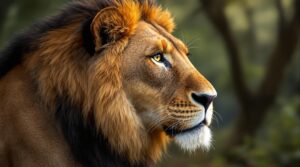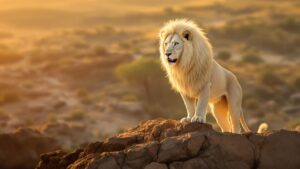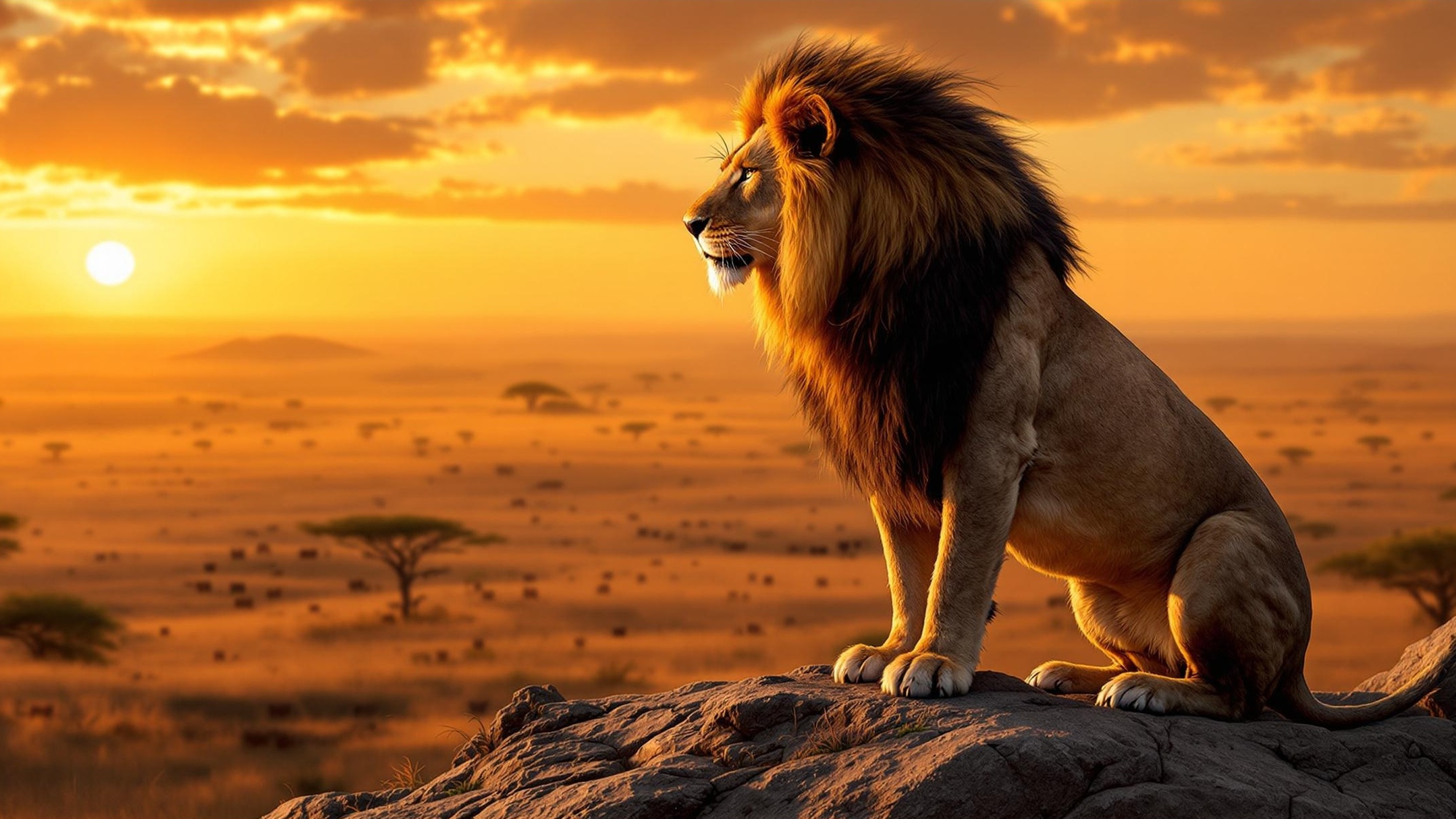Lions: Kings of the Wild and Guardians of the Grasslands
There is no creature more iconic in the animal kingdom than the lion. Regal, commanding, and deeply symbolic, lions have captured the imagination of humankind for millennia. From the stories of ancient civilizations to the flags of modern nations, the lion’s presence has always stood for courage, dominance, and nobility. But behind the legend lies a living, breathing species whose complex social lives, ecological influence, and evolutionary brilliance make them one of the most fascinating creatures on Earth.
This page explores the powerful world of lions—not just as a single species, but as a category of their own within the big cat family. We’ll explore their biological traits, unique social behaviors, and the variations across their populations. From the sun-drenched plains of Africa to the dwindling sanctuaries of Asia, lions exist at the intersection of nature’s raw beauty and the growing challenges of conservation. By understanding the different facets of lion life—from prides and hunting dynamics to subspecies and threats—we gain a deeper appreciation for their role in the natural world and why they must be protected.

African Lion
African Lion: The Iconic King of the Wild Powerful, majestic, and endlessly captivating, the African lion (Panthera leo leo) stands as one of the most recognizable animals on Earth. Revered across cultures and celebrated in everything from folklore to film, this great cat has earned its title as “King of the Jungle”—even though it lives primarily in grasslands, not jungles. With a commanding roar that echoes across the savanna and

Asiatic Lion
The Majestic Survivor of India’s Forests: The Asiatic Lion The Asiatic Lion, scientifically known as Panthera leo persica, is more than just a subspecies of the African lion—it’s a living legend. Residing exclusively in a small corner of India, this powerful predator once roamed from the Middle East to northern India. Today, it carries both the dignity of its royal past and the story of survival against all odds. Unlike

White Lion
The White Lion: Nature’s Living Legend of Light Among the most mysterious and visually captivating animals on Earth, the White Lion (Panthera leo krugeri) occupies a unique place in the pantheon of big cats. With its ghostly pale coat, piercing amber or blue eyes, and ethereal presence, the white lion has captured the imagination of cultures, conservationists, and wildlife lovers across the world. But beyond its beauty lies a fascinating
The Biological Blueprint of a Predator
Lions belong to the genus Panthera, making them one of the five big cats alongside tigers, jaguars, leopards, and snow leopards. Scientifically known as Panthera leo, lions are the second largest cats in the world after tigers. Their bodies are built for power—deep chests, muscular limbs, and a bone-crushing bite force. Males typically weigh between 330 to 550 pounds, while females range from 260 to 400 pounds, with size variation depending on region and subspecies.
One of the most recognizable features of lions, especially males, is their thick mane—a halo of fur that can range in color from blonde to black. The mane is more than decorative; it’s a signal of health, virility, and dominance. Lions also possess large paws with retractable claws, keen eyesight adapted for night vision, and padded feet that allow them to stalk prey with silence and precision.
What truly sets lions apart from other big cats is their social nature. They are the only truly social felines, living in structured groups known as prides. This trait has given rise to an entirely different set of behavioral dynamics compared to the solitary lives of tigers or leopards. Understanding these social structures is key to grasping the richness of lion society.
The African Lion: Dominant Force of the Savannah
The most well-known and widely distributed lion is the African lion. Found primarily in Sub-Saharan Africa, these lions inhabit a variety of ecosystems, including savannahs, grasslands, woodlands, and even semi-desert regions. African lions live in prides typically composed of related females, their cubs, and a coalition of one to three adult males. Female lions are the hunters of the group, working cooperatively to stalk and take down prey. Their hunting strategies are based on teamwork, stealth, and endurance. Prey animals include wildebeests, zebras, antelope, and occasionally buffalo or even giraffes. Males, while less involved in hunting, play a vital role in protecting the pride from rival males and predators like hyenas. Lion cubs are raised communally within the pride, with all females helping to nurse and guard them. This shared parenting gives lion cubs a better chance of survival, though mortality remains high due to predators, infanticide, and disease.
The roar of an African lion can be heard from up to five miles away and serves as a sonic marker of territory. This primal call is a declaration of power and a deterrent to potential intruders. African lions are apex predators, meaning they sit at the top of their food chain and help regulate herbivore populations, keeping ecosystems in balance.
The Asiatic Lion: The Endangered Ghost of Gir Forest
Far less known but equally important is the Asiatic lion, a subspecies found only in India’s Gir Forest National Park. Once ranging from the Middle East to India, these lions are now critically endangered, with only a few hundred individuals surviving in the wild. Asiatic lions differ subtly from their African relatives. They are slightly smaller, with shorter manes that expose their ears. Their body hair tends to be less dense, and they often display a distinctive fold of skin along their bellies. Socially, Asiatic lions tend to form smaller prides, and males often remain solitary or associate with a single female. Their diet includes deer, antelope, wild boar, and livestock in surrounding villages, which has led to frequent human-wildlife conflict. Conservation efforts in India have been relatively successful in preserving this population, but genetic bottlenecks, habitat encroachment, and disease remain serious threats.
The story of the Asiatic lion is one of survival against the odds. It’s a reminder that even the most legendary of animals can be pushed to the brink if not carefully protected and managed.
Prides and Coalitions: The Architecture of Lion Society
Lions are unique among cats for their deep social bonds. A typical pride consists of five to fifteen individuals, although some super prides can exceed twenty members. These social groups are built around related lionesses who remain in the pride for life, while males come and go depending on their ability to assert dominance. Males often form coalitions—groups of two to four brothers or close allies—that work together to take over and maintain control of a pride. When new males oust a reigning coalition, they often kill the existing cubs to bring the females into estrus more quickly, a brutal but evolutionarily efficient strategy to pass on their own genes. Within the pride, lions groom each other, play together, and communicate through vocalizations, facial expressions, and body language. Their cooperation in hunting, cub-rearing, and territory defense sets them apart from the rest of the big cat family.
This intricate social structure allows lions to dominate vast territories and outcompete other carnivores. Yet it also makes them vulnerable—if the social bonds of a pride are disrupted through poaching, disease, or human interference, the entire group can collapse.
Hunting and Feeding: Strategies of Strength and Precision
Unlike leopards or jaguars that often rely on solitary ambush, lions use strength in numbers to execute coordinated hunting strategies. A typical lion hunt begins with stalking—a low, quiet approach to within 30 to 100 feet of the target. Then comes the sprint, where the lioness accelerates to incredible speeds for short bursts before leaping onto her prey. Teamwork is especially important when hunting larger animals like buffalo or giraffes, which are too dangerous for a single lion to tackle alone. Females do most of the hunting, while males may assist on tougher kills or simply muscle in for first feeding rights. Lions consume up to 15% of their body weight in a single sitting and will gorge themselves when food is available. Feeding time often becomes chaotic, with snarling, growling, and physical skirmishes over access to meat. After feeding, lions rest for hours—sometimes days—digesting their meals and regaining energy.
Scavenging also plays a role in lion diets. Lions will chase other predators like hyenas and cheetahs off their kills, using intimidation and brute force to steal meals. This behavior reinforces their apex status but also breeds fierce competition with other carnivores in the ecosystem.
Sub-Categories Within the World of Lions
While lions are a single species with just two primary subspecies—the African lion and the Asiatic lion—their populations and behaviors vary across different habitats, which naturally divides them into sub-categories worthy of further exploration. Desert Lions are a population of African lions adapted to survive in the harsh Namib and Kalahari deserts. They are leaner, travel longer distances, and go without water for days, surviving on the fluids from their prey. Forest Lions are found in the dense rainforests of Central and West Africa. These lions tend to be smaller and more elusive than their savannah cousins and are increasingly threatened by habitat destruction and poaching. White Lions are a rare genetic variant of the African lion. They are not albino but possess a recessive gene that produces a pale, cream-colored coat. Once extinct in the wild, white lions have been reintroduced into protected areas through breeding and conservation efforts. Captive Lions, found in zoos, sanctuaries, and sadly, in private ownership, represent another category. While captivity can protect against extinction, it also raises ethical questions around conservation, animal welfare, and the role of tourism.
Each of these sub-categories brings its own story, challenges, and conservation needs. Exploring these distinctions allows us to better understand the adaptability and vulnerability of lions in a changing world.
Lions in Mythology, Culture, and Modern Media
Throughout history, lions have held a mythical status. In ancient Egypt, the lion-headed goddess Sekhmet symbolized power and protection. In Mesopotamian art, kings were often depicted slaying lions as a sign of dominance. Greek myths portrayed the Nemean lion as an invincible beast defeated only by Hercules. In India, the lion is associated with the goddess Durga, who rides one into battle against evil. Today, lions remain embedded in pop culture, from national emblems and sports team logos to animated films and nature documentaries. The lion’s majestic presence is universally recognized, making it a powerful ambassador for wildlife conservation.
But this fame comes at a cost. Trophy hunting, illegal wildlife trade, and exploitative tourism continue to put lions at risk. Education and responsible wildlife viewing are crucial steps in shifting public perception and generating support for lion conservation.
Conservation Challenges and the Fight for the Future
Lions once roamed across much of Africa, the Middle East, and even parts of Europe. Today, their range has shrunk dramatically. African lion populations have declined by more than 40% over the past few decades, while Asiatic lions cling to a single sanctuary in India. The primary threats to lions are habitat loss, human-wildlife conflict, poaching, and poorly regulated trophy hunting. As human populations expand and encroach on lion habitats, conflicts over livestock become more frequent and often deadly for lions. Conservationists are working on multiple fronts to protect lions. Protected areas, anti-poaching patrols, community engagement, and genetic diversity monitoring are all essential tools. Rewilding projects and breeding programs are also being explored to restore lion populations in areas where they have disappeared.
Public education and awareness are equally critical. The more people understand the ecological importance and social complexity of lions, the more likely they are to support their protection.
A Call to Explore and Protect the True Kings of the Wild
Lions are more than just charismatic predators. They are ecological keystones, cultural legends, and social innovators within the animal kingdom. Each sub-category—from desert lions and white lions to the Asiatic survivors of Gir Forest—reveals a different facet of the lion’s extraordinary story. By exploring these sub-categories, we gain insight into how lions live, adapt, and interact with the world around them.
As we journey through this site and explore each lion sub-category in detail, let us be inspired not only by their majesty but also by the urgency to protect them. The roar of a lion once echoed across continents. With the right knowledge, action, and reverence, perhaps it still can.

